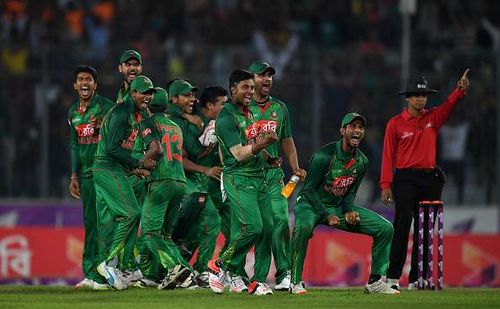
Bangladesh's onfield behavior leaves a lot to be desired
Bangladesh is a passionate nation when it comes to cricket. Probably more passionate than even India and Pakistan.
In India, the consumption of sports isn’t just limited to cricket now; a slowly but surely improving display at the Olympics, and the rise of cash-rich non-cricketing sports leagues have provided enough alternatives for Indians to explore apart from cricket. Pakistan, although not blessed like India in terms of sporting diversity, have their own share of hockey and squash heroes to fall back on, if the cricket team isn’t performing.
For Bangladesh, there haven’t been many sporting alternatives. Although they were once obsessed with football and possibly still are to some extent, the government's failure to develop football has essentially wiped out the game from the country. So their sporting conversations, more often than not, revolve only around the game of cricket.
The people of Bangladesh love their cricket and their cricketers. It shows in the jam-packed turnout during every home game they play; it shows in the fanatical response of the fans to every unjust event against them in the middle; and it also shows in the players, whenever they take the field for their country.
In a league match of the 2015 World Cup, Bangladesh celebrated their win against Afghanistan by taking a victory lap for half an hour, thanking the fans present in the stadium. Looking at them, any outsider not following the World Cup would have believed that Bangladesh had just lifted the trophy.
A full member of 14-years celebrating in such a manner against a low-ranked Afghanistan felt odd to an objective viewer. It even surprised coach Chandika Hathurusingha, who asked his players after the celebrations if winning this match was the only thing they had come to Australia for.
The trouble with the Bangladesh cricket team and their fans is that they are still living in 2006. 10 years ago, Bangladesh winning against India or England would have been considered an upset in the cricketing world. Not in 2016. But even today, the reaction by Bangladesh players to a match won is akin to that in 2006.
Some time ago, Harsha Bhogle made a point about why some teams are so consistent at winning cricket matches, and others not so much. He said if a team gets surprised at its own success, then it will find it difficult to succeed the next time it comes close to winning. Bhogle’s comments were vindicated by Bangladesh in Bangalore, when they failed to score two of three against India.
It seemed as if Mushfiqur Rahim had already won the game in his mind for Bangladesh when two runs were still needed for victory. He overwhelmed himself with thoughts of victory, and rather than dealing with the last two balls professionally, he played a rash shot to lose the game for his side.
Good teams win regularly because they consider winning a habit, and not an unfamiliar event. And Bangladesh are winning consistently enough now to not fall in this “minnow-mentality” trap time and again.
Even with their attitude on the field, the Bangladesh players at times don’t seem to act like seasoned professionals, but rather like some eternal underdogs who are trying to prove a point to the world. They are still acting like minnows; outlandishly celebrating wickets, hyping every single win even if it’s against newcomers like Afghanistan, and painting every alleged injustice against them in black and white. They have become a grown-up adult, who despite doing well in life, still suffers from insecurity – which probably springs from an identity crisis.
Recently in the second ODI against England, the send off Bangladesh players gave to Jos Buttler was totally unnecessary and could have been avoided. Last year, Mustafizur intentionally ran into the batsman’s path twice against India. It seemed as if Mustafizur wanted to show India that his team could bully others. Bangladesh were performing well in both those games, and they should have just stuck to letting their performance speak for them.
In the 2015 World Cup quarter-final, Mashrafe Mortaza cried foul after Rohit Sharma got a reprieve on a marginal no-ball. Mortaza could have taken it more sportingly, knowing bad calls are a part and parcel of cricket. But he did not.
Modern day cricket demands a team to be fiery and aggressive on the field. Ask any Australian cricketer and he would say toning down aggression affects the performance on the field. That’s why sledging is a key component of Australia’s game. Steven Smith recently went as far as saying that his squad had too many ‘nice guys’ and that’s why they lost the Test series to Sri Lanka. Even Darren Lehman expressed the same attitude, and called for sledging to be a key part of their game plan during the South Africa series.
Aggression helps. And sledging is a sub-set of aggression. So Bangladesh’s attempt to bring this dimension into their game on the field should ideally not be quelled. But the problem isn’t in being aggressive, it’s in their inability to distinguish when to use aggression effectively, and when to put the brakes on it. Unlike Australia, sledging isn’t coming naturally to them, and that’s the issue.
Bangladesh would do well to take a good look within, search for what works best for them as a form of self-expression, and then bring that original self on the field. If they can’t, then every act of their so-called aggression will continue to bear the brunt of public mockery.
